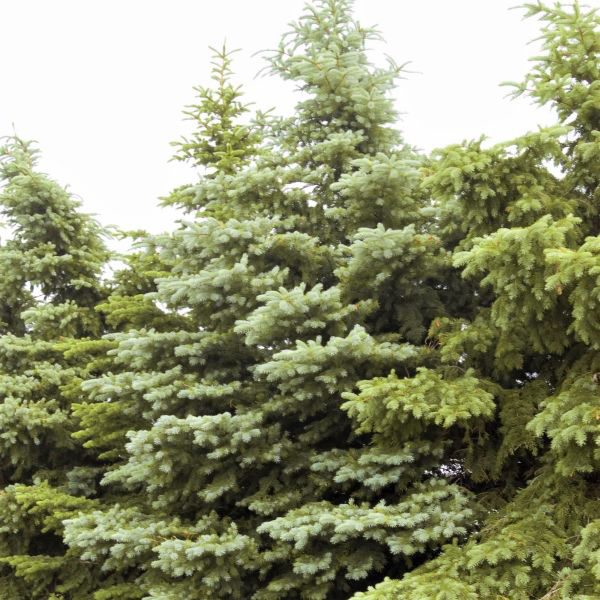
Colorado Spruce
Picea pungens
78 reviews
Colorado Spruce
Picea pungens
78 reviews
- Beautiful silver-blue color adds a unique touch to any landscape
- Can withstand harsh winter conditions, making it ideal for colder climates
- Low maintenance tree that requires minimal pruning and care
- Recommended by landscape designers for optimal fit in real yards
$90.00
$129.00
30% Off
- Ships to in 7-10 Days
- Free Shipping Over $150
- Plant Arrival Guarantee
- In Stock
- Free Plant Consult
$200 - Landscape-Approved: Every Plant We Sell Comes With Design Expertise Behind It
- 1.5 Gallon
- 3.5 Gallon 2-3 Feet
We are sorry, product is currently out of stock due to seasonal availability. Please check the "Related plants available in your area" section below
Not just beautiful - intentionally selected by ShrubHub's 3D landscape design team to fit real-world spaces and maximize yard potential.
Why Colorado Spruce?
The Colorado Spruce (Picea pungens) is a popular tree due to its attractive bluish-gray foliage and pyramid-like shape. It is tolerant of drought and adapts well to various soil conditions, making it suitable for landscaping. This coniferous evergreen tree also serves as a windbreak, providing privacy and protection. The Colorado Spruce's aesthetic appeal and resilience make it a favored choice in gardens and parks.
Sunlight
Colorado Spruce, also known as Blue Spruce, thrives best in full sun exposure. It requires at least 6 to 8 hours of direct sunlight daily to ensure optimal growth and development.
Watering
Colorado Spruce trees typically require deep and infrequent watering. They prefer well-drained soil and should be watered every one to two weeks, providing enough water to moisten the soil to a depth of about 12 inches.
Fertilizing
Colorado Spruce requires a balanced fertilizer with a ratio of nitrogen, phosphorus, and potassium (NPK) of approximately 10-10-10. However, it is recommended to conduct a soil test to determine the specific nutrient deficiencies and adjust the fertilizer
Colorado Spruce (Picea pungens)
The Colorado Spruce, scientifically known as Picea pungens, is a stunning evergreen tree native to the Rocky Mountains of the United States. With its majestic beauty and impressive size, it is a popular choice amongst homeowners, landscapers, and garden enthusiasts alike.
Description
The Colorado Spruce is a large tree that can reach heights of up to 60-75 feet with a spread of 20-30 feet. It boasts a dense and pyramidal shape, with strong, sturdy branches that are covered in short, gray-green to blue-green needles. The needles are sharply pointed and can be quite stiff, making this tree a great choice for adding texture and visual interest to any landscape.
Features
- Color: The Colorado Spruce is most famous for its stunning blue-green foliage, which adds a striking pop of color to any environment.
- Texture: The needles of the Colorado Spruce have a coarse texture and are moderately dense, providing a unique feel when touched.
- Shape: Its conical shape and dense branching structure make it an excellent choice for a natural privacy screen or windbreak.
- Growth Rate: This evergreen has a slow to medium growth rate, typically adding anywhere from 6 to 12 inches in height per year when young.
- Hardiness: The Colorado Spruce is a hardy tree that can withstand cold climates and harsh winter conditions.
Uses
The Colorado Spruce has numerous uses in landscaping and gardening:
- Ornamental Purposes: The distinctive blue-green color and beautiful shape of this tree make it a stunning addition to any garden or landscape.
- Privacy Screen: Due to its dense branching, the Colorado Spruce can be planted closely together to create an effective privacy screen or natural windbreak.
- Accent Tree: Planted as a single specimen tree, the Colorado Spruce provides a focal point in any landscape design.
- Christmas Tree: With its classic conical shape and festive color, the Colorado Spruce is a popular choice as a Christmas tree.
Care Instructions
Here are some essential care tips for maintaining a healthy Colorado Spruce:
- Location: Plant in a location that receives full sun to partial shade.
- Soil: The Colorado Spruce thrives in well-drained soil and can tolerate various soil types.
- Watering: Water regularly, making sure the tree receives sufficient moisture, especially during the dry summer months.
- Fertilization: Feed with a balanced fertilizer in the early spring to promote healthy growth.
- Pruning: Minimal pruning is required; only remove dead or damaged branches as necessary.
Whether you are looking to enhance the beauty of your garden or create a natural privacy screen, the Colorado Spruce is a fantastic choice. Its unique blue-green color, dense branching, and hardiness make it a highly sought-after tree for various landscaping purposes.
Plant Information:
| Botanical Name: | Picea pungens |
| USDA Zones: | 2 - 7 |
| Water: | Moderate |
| Exposure: | Full Sun |
| Soil Needs: | Well Drained |
| Mature Height: | 50 - 60 feet |
| Mature Spread: | 12 - 20 feet |







Pollination Info
Pollination Information for Colorado Spruce (Picea pungens)
The Colorado Spruce, scientifically known as Picea pungens, is a native coniferous tree found in the western United States. Its attractive blue-gray foliage and symmetrical shape make it a popular choice for landscape use. As a member of the Pinaceae family, these trees are wind-pollinated, meaning they do not rely on insects or animals for pollination.
Here are some key points about the pollination process of Colorado Spruce:
- Flowering: Colorado Spruce trees produce both male and female flowers, known as cones, which are the reproductive structures. The cones appear on the branches of the tree and go through a specific flowering process.
- Male Cones: The male cones of the Colorado Spruce are small and inconspicuous. They develop in the upper part of the tree and release pollen during springtime. The male cones are responsible for producing and dispersing the pollen grains.
- Pollen Dispersal: As a wind-pollinated tree, Colorado Spruce relies on the wind to carry the pollen from the male cones to the female cones. The lightweight pollen grains are released in large quantities, increasing the chances of successful pollination.
- Female Cones: The female cones of Colorado Spruce are larger and more recognizable than the male cones. They are usually located in the upper crown of the tree and have a distinctive cylindrical shape. The female cones have ovules that will potentially become seeds if pollination occurs.
- Pollination: Pollination in Colorado Spruce occurs when the wind carries the pollen grains from the male cones to the female cones. Once the pollen reaches the ovules in the female cones, fertilization takes place. This fertilization process results in the development of seeds inside the cones.
- Seed Development: After successful pollination, the Colorado Spruce cones gradually grow larger and turn brown. The fertilized ovules develop into seeds within the cones. It takes approximately one year for the seeds to fully mature.
- Seed Dispersal: Once the seeds are mature, the cones open up, allowing the seeds to be dispersed by the wind. This dispersal mechanism ensures the propagation of new Colorado Spruce trees.
It is important to note that Colorado Spruce trees can self-pollinate, meaning a single tree can produce viable seeds without the need for another tree nearby.
In summary, Colorado Spruce is pollinated by wind, and its male cones release pollen that is carried by the wind to reach the female cones. Successful pollination leads to seed development, which eventually results in the dispersal of new seeds for propagation.
FAQ
Frequently Asked Questions - Colorado Spruce (Picea pungens)
1. What is a Colorado Spruce?
The Colorado Spruce (Picea pungens) is a species of coniferous evergreen tree native to the Rocky Mountains of North America. It is known for its striking blue-green foliage and pyramid-like shape.
2. How tall does a Colorado Spruce tree grow?
Colorado Spruce trees can grow to an average height of 30 to 60 feet, with some exceptional specimens reaching up to 90 feet.
3. What are the ideal growing conditions for Colorado Spruce?
Colorado Spruce thrives in full sun to partial shade and prefers well-draining soil. It is adaptable to a wide range of soil types but performs best in moist, acidic soils. It is also highly tolerant of cold temperatures.
4. How fast does a Colorado Spruce tree grow?
The growth rate of a Colorado Spruce tree is relatively slow, typically averaging around 6 to 12 inches per year.
5. What are the water requirements for Colorado Spruce?
While they prefer moist soil, established Colorado Spruce trees are quite drought-tolerant. However, regular watering during dry periods is recommended, especially for younger trees.
6. How often should I prune my Colorado Spruce?
Pruning is generally not necessary for Colorado Spruce trees, except for removing any dead or damaged branches. If desired, shaping or light pruning can be done in early spring before new growth emerges.
7. Are Colorado Spruce trees susceptible to any diseases or pests?
Colorado Spruce trees can be susceptible to certain pests, including spruce mites, adelgids, and spruce budworms. They may also suffer from diseases such as Cytospora canker and needle cast. Regular inspection and early intervention can help prevent and manage these issues.
8. Can Colorado Spruce be grown in containers or as bonsai?
Yes, Colorado Spruce can be grown in containers and as bonsai if provided with proper care. However, it is essential to choose a suitable container size and provide adequate watering and fertilization.
9. How can I propagate Colorado Spruce?
Colorado Spruce can be propagated through seeds or by taking semi-hardwood cuttings in late summer. Growing from seeds may take longer to produce mature trees compared to cuttings.
10. Are Colorado Spruce trees deer-resistant?
Colorado Spruce trees are generally considered deer-resistant due to their prickly needles and strong aroma. However, hungry deer may occasionally feed on young foliage, especially during winter when other food sources are scarce.
Planting & Care
Planting & Care for Colorado Spruce (Picea pungens)
Planting:
- Choose a location with well-drained soil and full sun exposure.
- Dig a hole that is twice the size of the root ball of the tree.
- Gently remove the tree from its container, or if it's balled and burlapped, cut away any twine or string.
- Place the tree in the hole, making sure it's centered, and backfill the hole with soil. Tamp down the soil firmly around the root ball to remove any air pockets.
- Water the tree thoroughly after planting.
- Note: It's recommended to plant Colorado Spruce trees in the spring or early fall.
Care:
- Watering: Colorado Spruce trees require regular watering, especially during the first few years of growth. Water deeply once a week, ensuring the soil is moist but not waterlogged.
- Mulching: Apply a layer of mulch around the base of the tree, keeping it at least 2-3 inches away from the trunk. Mulching helps retain moisture, suppress weeds, and insulate the roots.
- Pruning: Prune Colorado Spruce trees in late winter or early spring, before new growth starts. Remove any dead, damaged, or diseased branches. Avoid excessive pruning as it can affect the tree's natural shape.
- Fertilizing: Fertilize the tree in early spring using a slow-release, well-balanced fertilizer. Follow the manufacturer's instructions for application rates.
- Pests and Diseases: Colorado Spruce trees are generally resistant to pests and diseases. However, they can be susceptible to spruce needle rust, needle cast diseases, and spider mites. Regular inspection and appropriate treatment, if necessary, can help prevent or control these issues.
- Winter Protection: Colorado Spruce trees are well-suited to cold climates but may benefit from winter protection in harsh conditions. Use burlap or a similar material to wrap the tree loosely to prevent excessive snow accumulation and wind damage.
Check Out These Verified Customer Reviews:
Customer Reviews
4.7 out of 5 based on 78 reviews
Thank you! Your review has been submitted.
Beautiful Colorado Spruce. Looks amazing in my yard.
Top-notch quality tree that exceeded my expectations. The branches are sturdy and easy to decorate.
Item arrived in great condition. Very pleased with quality.
Item has been added to your cart.


